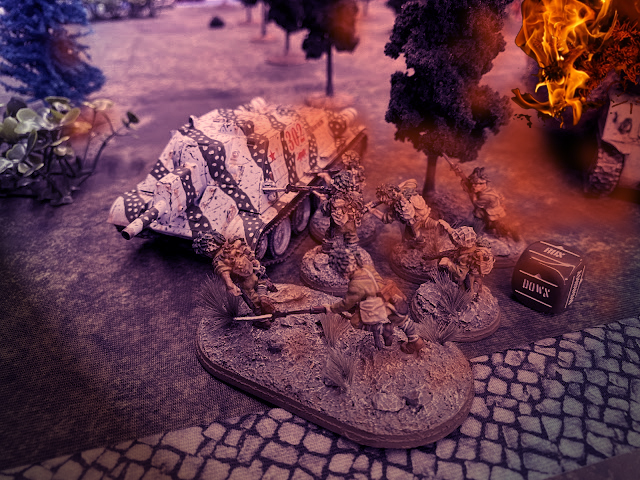For our latest game of Bolt Action, Art and I decided to fight the Battle of Mutanchiang from 1945. The Soviet Union had declared war against Imperial Japan and launched an overpowering night assault against the city of Mutanchiang, which was being used by the Kwantung Army as a base of operations. The Japanese army decided to fight a rearguard action, leaving a skeleton force to slow the Soviet advance while the majority of the army evacuated to Tunghua.
For this scenario, The Soviets had to get at least half their units across the table and through the three available exit routes before time ran out. The Japanese were dug into the ruins, with additional fortifications of barbed wire, minefields, anti-tank ditches, and a roadblock. We also used the "Flare!" night fighting rules, so visibility varied from round to round.
Round 1:
Flare were sent up by the Soviets, illuminating the city ruins. However, the Japanese chose to remain hidden.
The Soviets launched a preparatory bombardment of the city prior to advancing. Many of the Japanese units were stunned and received pin markers, but all survived. However, the roadblock and a section of barbed wire were destroyed.
Round 2:
As the flares faded, the Soviets began advancing in earnest.
The Japanese used the rest of the round to rally troops and shed pin markers.
Round 3:
Another round began in darkness. The Katyusha launched a second rocket barrage against the ruins, this time killing the Japanese Major in charge of this sector.
A second Soviet Sherman approached the Japanese defenses, wary of a patch of freshly dug earth in front of the barbed wire. It opened fire on the shadows moving behind the barricades, but was ineffective.
A Japanese machine gun team spotted arriving Soviet transports, opening fire on one. They managed to hit a fuel tank, destroying the truck and killing some of the infantrymen. The survivors scurried into the underbrush, their morale shaken.
Round 4:
More flares went up from the Soviets, A Japanese sniper team worked to pick off the survivors of the burning truck.
A third Soviet Sherman arrived and quickly decimated a squad of Japanese infantrymen. The lone survivor quickly fled into the dark. To patch the gap in the defenses, another infantry squad arrived, along with a suicide anti-tank hunter.
Soviet infantry arrived at another Japanese barricade and were quickly run across the disturbed earth by their commanders. The lack of explosions showed there were no anti-personal mines, but likely anti-vehicle mines. With the support of the Sherman's machine gun, a firefight broken out with the Japanese infantry.
Another unit of Japanese in the adjacent building prevented a second Soviet squad from completing a flanking attack.
Round 5:
Under the continued light of the flares, intense fighting raged on in the roadway, while a Soviet tank destroyer also arrived on the scene.
Hand to hand combat broke out between the second Soviet and Japanese squads, with the Soviets eventually taking the upper hand and entering the building.
With the clock ticking, the first Soviet Sherman chose to bypass the ineffective Chi-Ha and brave the anti-tank ditch. In their haste, the Japanese had not dug deep enough, and the Sherman successfully crossed it. The tank also spotted the suicide anti-tank hunter hiding on the other side, and gunned him down before he could run in for the kill.
Defeating the Japanese on the street, the Soviet infantrymen made a run for their exit point while dodging shots from the ruins.
The second Soviet squad eliminated another suicide anti-tank hunter lurking behind a truck.
As the Soviet tanks prepared to exit through the breached Japanese defenses, another Japanese infantry squad and suicide anti-tank hunter exited the ruins to launch a flank attack.
Round 6:
Before the Soviets could react to the new threat, the tank hunter launched himself against the rear of the third Sherman, blowing the tank and himself to pieces.
The surviving Sherman quickly dashed down the road before the other Japanese infantry could catch it.
The Japanese infantry pivoted in their target, and instead went after the Soviet tank destroyer. Despite their banzai passion, the attack was ineffective against the tank destroyer's armor. However, the tank destroyer chose to beat a hasty retreat.
With time almost out, the Katyusha tried to find an exit that would keep it away from the main battle.
The surviving Soviet infantry units quickly ran past the last of the Japanese defenses to their exit point.
At this stage, not enough Soviets had made it past the Japanese defenses for a victory, so Art's only hope was for the dice to give him an extension and get one more unit off the table. Would there be a ...
Round 7:
Yes.
The last of the Soviet Shermans was unwilling to risk crossing the minefield, so opened fire on the Japanese machine gun team.
With the tank destroyer too far away for a second attack, the Japanese launched an unsuccessful attack on the Sherman. The Soviet survivors of the burning truck managed to launch a counter attack on the Japanese infantry.
Additional Japanese reinforcements arrived, but could nothing more than man the barricades again.
The tank destroyer and Katyusha were unsuccessful in exiting the battlefield.
And with that, the battle was over. Despite inflicting heavy casualties on the Japanese and moving several units past their defenses, the Soviets were still one unit short to declare victory. The Japanese rearguard had held on long enough to get the bulk of their forces out of the city, and the war would continue.



































